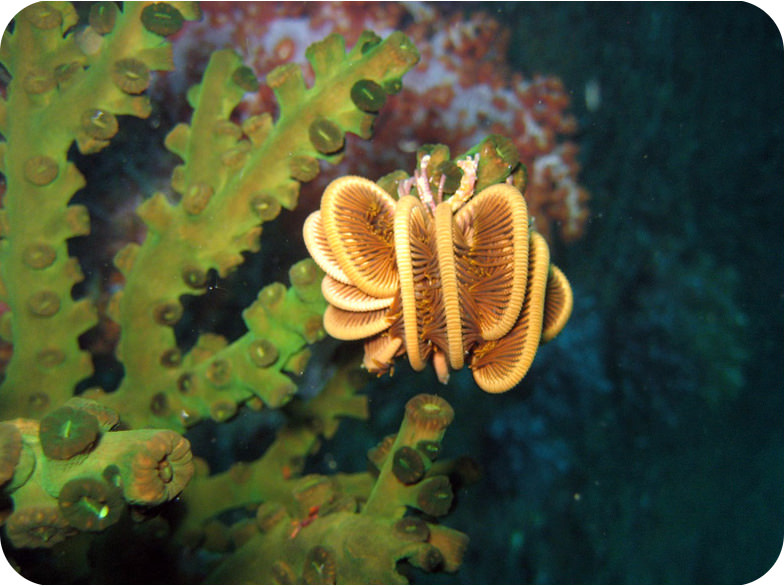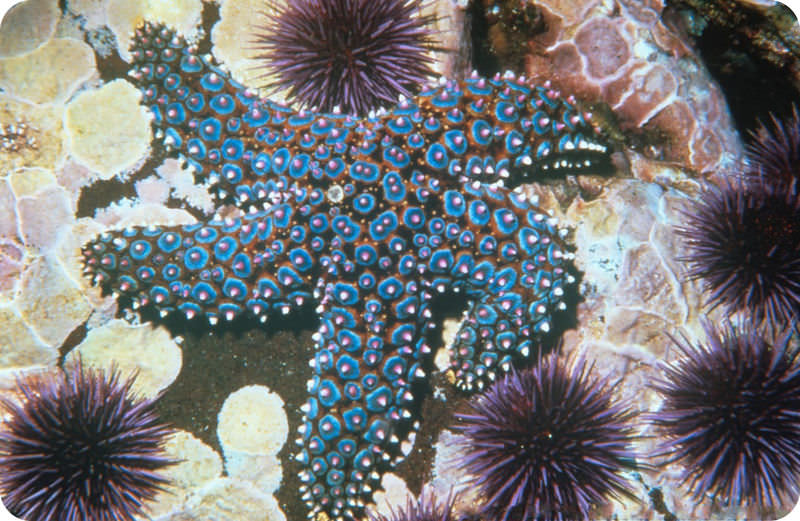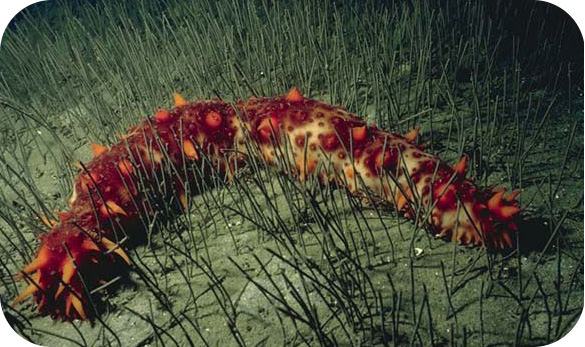11.12 近效器
章节大纲
-
Believe it or not, this is an animal. See the mouth and arms?
::信不信由你,这是动物 看到嘴巴和手臂了吗?It is a sea lily, a crinoid echinoderm. Crinoids are essentially a mouth on the top surface that is surrounded by feeding arms. Although the basic echinoderm pattern of fivefold symmetry can be recognized, most crinoids have many more than five arms. Crinoids usually have a used to attach themselves to a surface, but many become free-swimming as adults.
::它是一种海,一种树脂,一种树脂,一种树脂。 树脂基本上是顶部表面的嘴,周围是用手喂养的。 虽然可以识别五倍对称的基本石脂模式,但大多数树脂的手臂超过五根。 树脂通常有固定在表面的习惯,但许多人成年后会自由游动。Echinoderms
::近效镇镇静剂Echinoderms are organisms that make up the phylum Echinodermata . They can be found in the ocean from the equator to the poles. There are roughly 6000 living of echinoderms. They are among the most distinctive organisms within the . Members of the phylum include sea stars (starfish), sand dollars, and feather stars, shown in Figure .
::Echinodems是构成植物类的有机体,从赤道到极地都可以在海洋中找到,约有6 000个生态系生物,它们是该体内最独特的有机体之一。 植物类成员包括海星(海星)、沙元和羽状星,如图所示。Examples of Echinoderms. You may have seen sea stars and sand dollars at the beach because they live in shallow water near the shore. Other echinoderms, such as feather stars, are less commonly seen because they live in the deep ocean. Structure and Function of Echinoderms
::杂质物质的结构和功能Echinoderms are named for their “spiny skin.” However, the spines aren’t on their skin. They are part of the endoskeleton . The endoskeleton consists of calcium carbonate plates and spines, covered by a thin layer of skin. Adult echinoderms have radial symmetry . This is easy to see in the sea star and sand dollar in Figure . However, echinoderms evolved from an ancestor with bilateral symmetry . Evidence for this is the bilateral symmetry of their larvae .
::以其“皮肤皮质”命名的叶质镇静剂。 然而,脊椎并不在皮肤上,它们是内骨骼的一部分。内骨骼由碳酸钙板和脊椎组成,由薄皮层覆盖。成人脑电极具有辐射对称性。这在海星和图中的沙元中是很容易看到的。然而,脑膜从具有双边对称性的祖先演变而来。 这方面的证据是幼虫的双边对称性。A unique feature of echinoderms is their water vascular system . This is a network of canals that extend along each body part. In most echinoderms, the canals have external projections called tube feet (see Figure ). The feet have suckers on the ends. Muscle contractions force water into the feet, causing them to extend outward. As the feet extend, they attach their suckers to new locations, farther away from their previous points of attachment. This results in a slow but powerful form of movement . The suckers are very strong. They can even be used to pry open the shells of prey .
::脑电极的一个独特特征是它们的水血管系统。 这是一条贯穿每个身体部位的运河网络。 在大多数脑电极中, 运河有外部预测称为管脚(见图 )。 脚端有吸尘器。 肌肉收缩将水压到脚上, 导致它们向外延伸。 随着脚伸展, 它们把吸水器绑在新的位置上, 远离先前的附着点。 这导致了缓慢但强大的移动形式。 吸水器非常强大。 它们甚至可以用来打开猎物的外壳 。Tube Feet of a Sea Star. The tube feet of a sea star (in white) are part of its water vascular system. There is a sucker on the end of each foot that allows the animal to “walk” slowly over a surface. The suckers are strong enough to pry open shells. Echinoderms lack respiratory and excretory systems. Instead, the thin walls of their tube feet allow oxygen to diffuse in and wastes to diffuse out. Echinoderms also lack a centralized . They have an open circulatory system and lack a heart. On the other hand, echinoderms have a well-developed coelom and a complete digestive system . Echinoderms use pheromones to communicate with each other. They detect the chemicals with sensory on their body surface. Some echinoderms also have simple ( ocelli ) that can sense light. Like , echinoderms have the ability to regenerate a missing body part.
::神经化物缺乏呼吸和排泄系统。相反,它们管脚的薄壁允许氧气散入和废物散出。 神经化物也缺乏中央系统。 它们有一个开放的循环系统,缺乏心脏。 另一方面, 神经化物有一个发达的阴道和一个完整的消化系统。 神经化物使用pheomones互相交流。 它们用感官探测到身体表面的化学物质。 有些神经化物也有简单的(ocelli)能感知光。 比如, 脑化物有能力再生缺失的人体部分。Echinoderm Reproduction
::乙基尼代氨Some echinoderms can reproduce asexually by fission, but most echinoderms reproduce sexually. They generally have separate sexes and external . Eggs hatch into free-swimming larvae. The larvae undergo metamorphosis to change into the adult form. During metamorphosis, their bilateral symmetry changes to radial symmetry.
::有些脑电离子可以因裂变而发生性生殖,但大多数脑电离子可以发生性生殖,它们通常有不同的性别或外部生殖。蛋会孵化成自由游泳的幼虫。幼虫会发生变形,以改变成成人形态。在变形过程中,它们的双边对称性会改变对射线对称性。Echinoderm Classification
::尼氯化合物分类分类Living echinoderms are placed in five classes. These five classes show many similarities. Organisms in each class are described in Table .
::活的脑电图分五类,这五类有许多相似之处。Class (includes) Description Example Crinoidea
::白硅酸酯-
feather stars
::羽羽羽星星 -
sea lilies
::海海百合
fewer than 100 species; many have more than five arms; earliest and most primitive echinoderms; live on the ocean floor, mainly in deep water; filter feeders feather star
::羽羽羽星星Asteroidea
::阿斯色化物-
sea stars
::海洋恒星
almost 2000 species; most have five arms; many are brightly colored; live on the ocean floor, mainly in shallow water; predators or scavengers sea star
::海洋恒星Ophiuroidea
::欧花亚acolor-
brittle stars
::圆体恒星
about 2000 species; central disk distinct from arms; move by flapping their arms, which lack suckers; live on the ocean floor in shallow or deep water; predators, scavengers, deposit feeders , or filter feeders brittle star
::核颗粒星Echinoidea
::乙酰胆碱酯-
sea urchins
::海胆 -
sand dollars
::沙沙美元 -
sea biscuits
::海饼干 -
heart urchins
::心脏中转胆
about 100 species; do not have arms but do have tube feet; have a specialized mouth part with teeth to scrape food from rocks; live on the ocean floor in shallow or deep water; predators, herbivores , or filter feeders sea urchin
::海胆Holothuroidea
::全光极亚-
sea cucumbers
::海黄瓜
about 1000 species; long body without arms; unlike other echinoderms, have a ; live on the ocean floor in shallow or deep water; deposit feeders, or filter feeders sea cucumber
::黄瓜Summary
::摘要-
Echinoderms are marine invertebrates. They include sea stars, sand dollars, and feather stars.
::生态系系海洋无脊椎动物,包括海星、沙子和羽毛星。 -
Echinoderms have a spiny endoskeleton. They have radial symmetry as adults but bilateral symmetry as larvae.
::Echinodems有脊椎内骨骼,它们与成人一样有辐射对称,但与幼虫一样有双边对称。 -
Echinoderms have a unique water vascular system with tube feet. This allows slow but powerful movement.
::支气管具有独特的水管血管系统,有管脚,可以缓慢但有力的运动。
Review
::回顾-
Describe the echinoderm endoskeleton.
::描述一下内骨骨骼的电介质 -
Give an example of an organism in each class of living echinoderms.
::举个例子来说明 每类活的脑电图中的有机体 -
Adult sea stars and other echinoderms have obvious radial symmetry. What evidence supports the claim that echinoderms evolved from an ancestor with bilateral symmetry?
::成年海洋恒星和其他电子电离层具有明显的辐射对称性。 有何种证据支持这样的主张,即电子电离层从具有双边对称性的祖先演变而来? -
Explain the structure and function of the water vascular system.
::解释水血管系统的结构和功能。
-
feather stars







